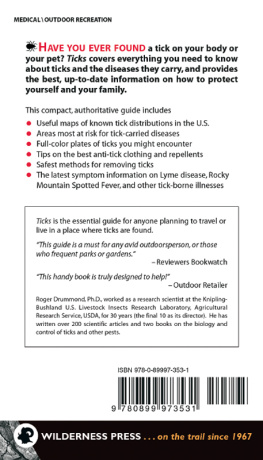About the Author
Susan Carol Hauser teaches in the English Department at Bemidji State University in northern Minnesota. She has been a commentator on National Public Radio.
Books by Susan Carol Hauser
Natural History
Wild Rice Cooking: History, Natural History, Harvesting, and Lore, with Recipes
Sugaring: A Maple Syrup Memoir
A Field Guide to Poison Ivy, Poison Oak, and Poison Sumac: Prevention and Remedies
Nonfiction
You Can Write a Memoir
Full Moon: Reflections on Turning Fifty
Girl to Woman: A Gathering of Images
Which Way to Look
Meant to Be Read Out Loud
What the Animals Know
Poetry
Outside after Dark: New & Selected Poems
Redpoll on a Broken Branch
A Field Guide to Ticks
Help Us Keep This Guide Up to Date
Every effort has been made by the author and editors to make this guide as accurate and useful as possible. However, many things can change after a guide is publishedscience progresses, regulations change, techniques evolve, facilities come under new management, and so on.
We welcome your comments concerning your experiences with this guide and how you feel it could be improved and kept up to date. While we may not be able to respond to all comments and suggestions, well take them to heart, and well also make certain to share them with the author. Please send your comments and suggestions to the following address:
The Globe Pequot Press
Reader Response/Editorial Department
P.O. Box 480
Guilford, CT 06437
Or you may e-mail us at:
editorial@GlobePequot.com
Thanks for your input, and stay healthy!

To buy books in quantity for corporate use or incentives, call (800) 9620973 or e-mail premiums@GlobePequot.com.
FALCONGUIDES
Copyright 2001, 2008 by Susan Carol Hauser
Previously published as Outwitting Ticks
ALL RIGHTS RESERVED. No part of this book may be reproduced or transmitted in any form by any means, electronic or mechanical, including photocopying and recording, or by any information storage and retrieval system, except as may be expressly permitted in writing from the publisher. Requests for permission should be addressed to The Globe Pequot Press, Attn: Rights and Permissions Department, P.O. Box 480, Guilford CT 06437.
Falcon and FalconGuides are registered trademarks of Morris Book Publishing, LLC.
Text design by Sheryl P. Kober
Illustrations by Diane Blasius unless otherwise credited
Library of Congress Cataloging-in-Publication Data
Hauser, Susan, 1942-
A field guide to ticks : prevent and treat lyme disease and other ailments caused by ticks, scorpions, spiders, and mites / Susan Carol Hauser. 2nd ed.
p. cm.
Previous ed.: Outwitting ticks, 2001.
Includes bibliographical references and index.
ISBN-13: 978-0-7627-4740-5
1. Tick-borne diseasesUnited States. 2. Ticks as carriers of diseaseUnited States. 3. TicksUnited States. 4. Lyme diseaseUnited States. I. Title.
RA641.T5H38 2008
362.196968dc22
2007049924
Printed in the United States of America
10 9 8 7 6 5 4 3 2 1
The author and The Globe Pequot Press assume no liability for accidents happening to, or injuries sustained by, readers who engage in the activities described in this book.
For Joani Becker, tick wrangler
Preface
My first encounter with tickswood ticks, also called dog tickswas a formative event in my life. I was young, maybe eight years old. I was a city girl, but was visiting my grandparents at their cabin in northern Minnesota. I had my dolls with me, and one day I found the perfect place to play with them: under the high skirt of a massive pine tree. I was happily engrossed in my little-girl-as-mommy fantasy when a neighbor boy, about twelve years old, stopped by. He peered in at me through the branches of my tree. I wouldnt play under there, he said, in a know-it-all tone.
Why not? I countered.
Wood ticks, was his simple reply.
I didnt know about wood ticks, but he showed them to me. They were crawling all over my arms and legs and clothes, and the arms and legs and clothes of my dolls. I dont remember my exit from the filtered light of my pine-tree world, but I know that nature was not the same for me after that.
In those days, around 1950, nobody liked wood ticks. They were creepy and sneaky and disgusting. But for the most part, our horror was confined to the realm of aesthetics. A tick not immediately discovered on the body glommed onto it and resisted removal. The bite itched after the tick was pulled off, sometimes for days. Ticks found on the dog were even worse because they concealed themselves in the dogs fur until they were bloated. Sometimes they remained undetected until they were sated and fell off their host, dropping onto the floor, a large, liver-colored, glistening pearl easily squashed by the bare foot of a child.
In spite of their bad reputation, we considered ticks to be benign. Still, it seemed a bad idea to share blood with one, and in some ways when the saga of the Lyme tick began to unfold in the 1980s, I was not surprised. It was merely confirmation of a niggling fear Id had since the episode under the pine tree thirty years earlier: Ticks were not just ugly in appearance and behavior; they were dangerous.
Although I was an adult when Lyme disease made headlines, I was not the least bit comforted by the assertion that wood ticks and Lyme ticks were different, and that wood ticks did not carry Lyme disease. After all, they werent even sure what Lyme disease was; how could they be so confident that wood ticks were not implicated? The news that Lyme ticks, also called deer ticks and blacklegged ticks, were very tiny added to my anxiety, as did the news that deer and mice played some role in the whole Lyme disease pageant.
As an adult I moved to rural northern Minnesota, land of wood ticks and even a Wood Tick Festival, and comforted myself for a long time with the notion that Lyme disease was an East Coast thing. Then we began to hear that you could get Lyme disease in Minnesota. The deer that roamed our yard and the mice in our woodpile were carriers of the Lyme disease germ. I had to come to terms with the vicissitudes of nature. I have been able to do that in large part because I have also come to believe in the old saw that knowledge is power.
A while ago my editor at The Globe Pequot Press called and asked if I would write a book on Lyme disease and related bug-inspired afflictions. Ewww, I thought to myself. Ticks. Do I really want to know more? Could I come to love the beauty of a tick kiss, and the elegant survival of a bacterium similar to the one that causes syphilis? Could I muster the courage to look straight on at a detailed drawing of the business end of a tick? Would I forever be glad that I pushed myself down the crooked path of science, or would I forever fear to leave my house?
Did I want the power of knowledge on this subject? My mind said yes; my heart searched for a dolly to cling to. Together, heart and mind, I decided I would sally forth into a microscopic world where there is neither mind nor heart, only survival. Yes, I would write the book. In the end, I find that knowledge is something to cling to, and that it comforts me, as I hope it does you.
Acknowledgments
My thanks to the following for their contributions to this book:
Steven Clemenson, M.D.
Patrick Guilfoile, Ph.D.
Lori Harms, D.V.M.
Introduction
In 2001, when this book was first published as Outwitting Ticks , the mystery of the origins of Lyme disease and the role of the deer tick, Ixodes scapularis , in its transmission were well known. Since then, deer ticks have not changed their habits, nor has the Lyme disease germ, Borrelia burgdorferi . Since 1997 Lyme disease cases have been reported in every state with the exception of Montana. In some states it is rare, such as Alaska, Hawaii, Mississippi, North Dakota, South Dakota, and Colorado. In some states, particularly in the Northeast and the Midwest, reported cases generally continue to increase in number (Centers for Disease Control; www.cdc.gov).









